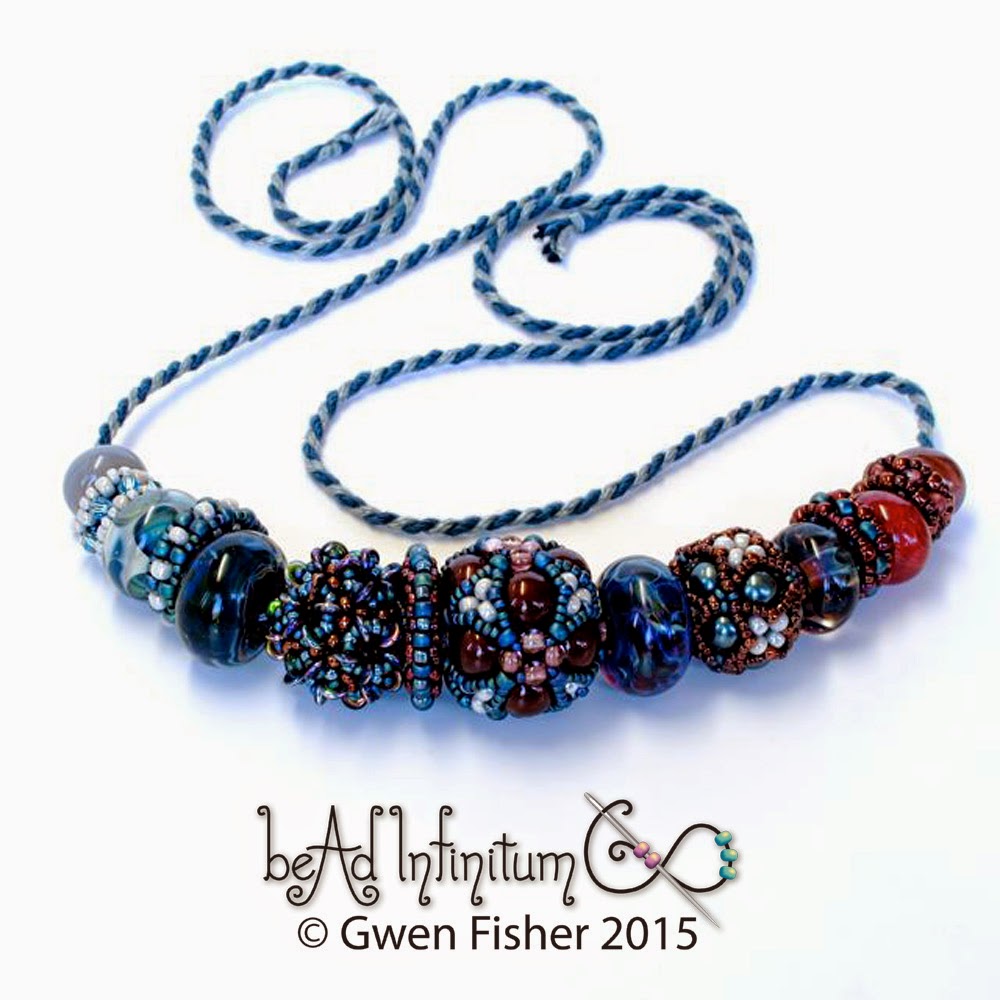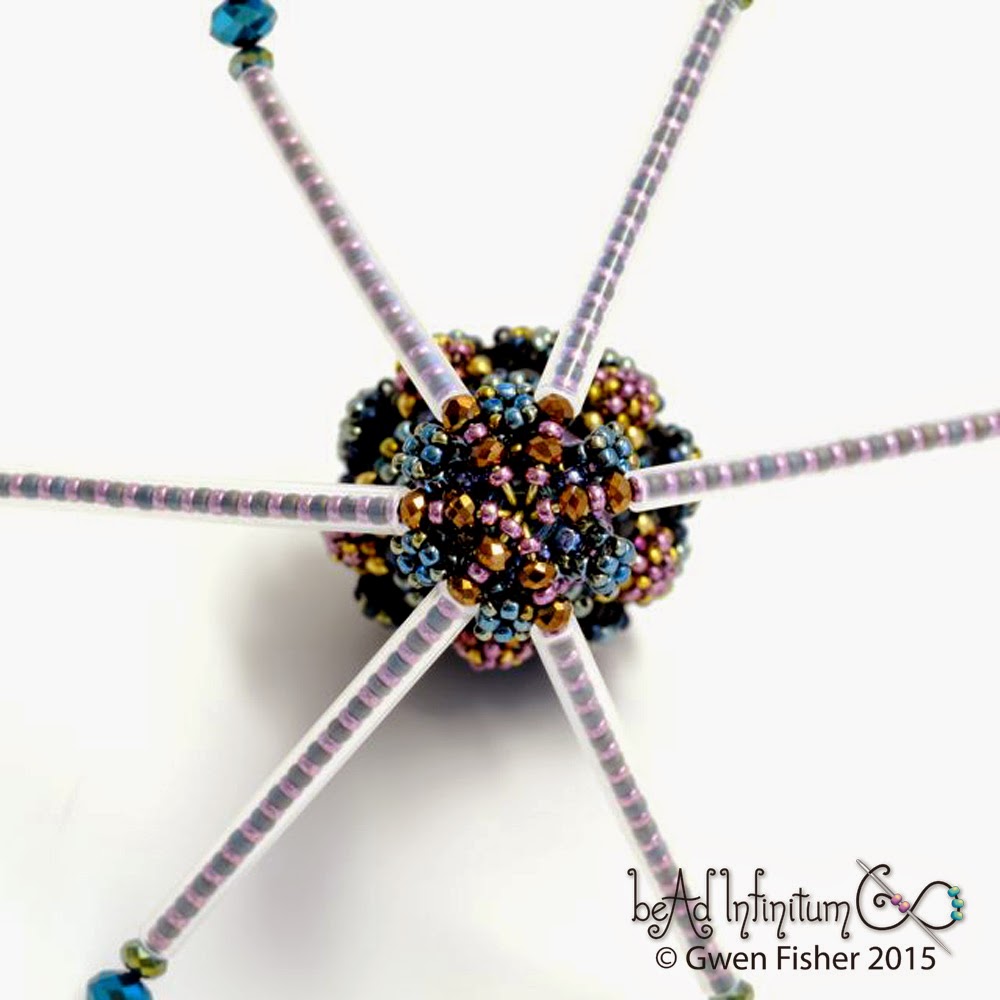Maybe you read my paper on using tiling theory to generate angle weaves with beads (PDF). Then again, maybe you didn't. One of the most elegantly simple weaves that I presented in that paper is what I called, "David's Star." You can read about it on pages 12 and 13, and even if you don't want to read anything, you can look at the three bracelets on page 13 that use the same technique as I show here.
I derived David's Star using mathematics, in particular the mathematics of tilings or tessellations. Using a tiling to describe this weave, David's Star is the edge-and-cover angle weave for (6.6.6). Let me explain that mouthful. First we start with the regular tiling by hexagons, like what we commonly see in natural honeycombs. This tiling is the black lines labeled (6^3) below. The standard notation for this tiling is (6.6.6), or (6^3) for short. The 6 is because the tiles all have 6 sides (i.e., they're hexagons), and the 3 is for the 3 hexagons that meet at each vertex.
The dark blue edge beads are the beads that you place on all of the edges of the tiling, the black line segments. The cover beads are the beads that cover the thread between the edge beads when you sew each hexgon of beads in a loop of thread. All of the non-dark-blue beads in the picture are cover beads. So, David's Star is the edge-and-cover angle weave for (6.6.6).
I like this bead weave for several reasons. First, it is very simple to stitch and works up relatively quickly. Therefore, I think it's a good pattern for beginners who want to make a wide flat bracelet. Second, the arrangement of beads allows for lots of different and beautiful ways to color the beads. Finally, the beads fit together really well: David's Star doesn't show thread or bead holes. Oh, and one more thing, you can weave it in any direction.
I drew this picture today in preparation for an invited plenary talk and workshop I'll be giving in Washington State in April at a math conference. For a moment, I considered writing up a complete tutorial and putting it in my Etsy shop. Then I reconsidered. For something this simple and basic to the art and math of beadweaving, I think this information should be generally available for free to those who are interested. So here it is. Also, a lot of people over the years have suggested that we should use beading more to teach mathematics, and I think that this particular weave is a nice choice for a math lesson. I made the beadwork in the photos here with pony beads and fishing line, and without a needle. Beading the patch above is a good lesson in visualization. Using pony beads and fishing line or stretchy thread makes it suitable for children and adults alike. Thin yarn with a size 10 tapestry needle is also a good choice. The friction on the yarn helps hold the beads together.
After trying this pattern, you can ask lots of extension questions in both math and art. For example, ask, "What does an edge only weave of (6.6.6) look like?" (Answer: Hexagon angle weave.) Or you could ask, "Draw the tilings (4^4) and (3^6)." "Can you draw the edge-and-cover weaves for these tilings?" and, "Can you bead weave them?" The answers to these questions are explored in the paper I linked to above.
If you want to play with the art, draw a picture of an interesting coloring for David's Star and then weave it. If you want a real challenge, (1) pick your own tiling, (2) draw an edge-and-cover weave for it, and then (3) bead it.
If you made it this far, please remember, I make most of my living selling my tutorials and other artwork. So if you liked this little free-bee, and try it yourself or with a kid, maybe you'll be so pleased that you'll want to hop over to my website or Etsy shop and show your appreciation by buying something. It's like a buy-one-get-one-free, but in the opposite order. If you've already purchased something, then consider this a thank you gift for supporting my work as an artist and teacher. Without you, I couldn't afford the time to write this blog every week, and I'd have to get a normal job. In any case, I hope you enjoyed this little mathematical beading lesson. Thanks for looking.
I derived David's Star using mathematics, in particular the mathematics of tilings or tessellations. Using a tiling to describe this weave, David's Star is the edge-and-cover angle weave for (6.6.6). Let me explain that mouthful. First we start with the regular tiling by hexagons, like what we commonly see in natural honeycombs. This tiling is the black lines labeled (6^3) below. The standard notation for this tiling is (6.6.6), or (6^3) for short. The 6 is because the tiles all have 6 sides (i.e., they're hexagons), and the 3 is for the 3 hexagons that meet at each vertex.
The dark blue edge beads are the beads that you place on all of the edges of the tiling, the black line segments. The cover beads are the beads that cover the thread between the edge beads when you sew each hexgon of beads in a loop of thread. All of the non-dark-blue beads in the picture are cover beads. So, David's Star is the edge-and-cover angle weave for (6.6.6).
I like this bead weave for several reasons. First, it is very simple to stitch and works up relatively quickly. Therefore, I think it's a good pattern for beginners who want to make a wide flat bracelet. Second, the arrangement of beads allows for lots of different and beautiful ways to color the beads. Finally, the beads fit together really well: David's Star doesn't show thread or bead holes. Oh, and one more thing, you can weave it in any direction.
I drew this picture today in preparation for an invited plenary talk and workshop I'll be giving in Washington State in April at a math conference. For a moment, I considered writing up a complete tutorial and putting it in my Etsy shop. Then I reconsidered. For something this simple and basic to the art and math of beadweaving, I think this information should be generally available for free to those who are interested. So here it is. Also, a lot of people over the years have suggested that we should use beading more to teach mathematics, and I think that this particular weave is a nice choice for a math lesson. I made the beadwork in the photos here with pony beads and fishing line, and without a needle. Beading the patch above is a good lesson in visualization. Using pony beads and fishing line or stretchy thread makes it suitable for children and adults alike. Thin yarn with a size 10 tapestry needle is also a good choice. The friction on the yarn helps hold the beads together.
After trying this pattern, you can ask lots of extension questions in both math and art. For example, ask, "What does an edge only weave of (6.6.6) look like?" (Answer: Hexagon angle weave.) Or you could ask, "Draw the tilings (4^4) and (3^6)." "Can you draw the edge-and-cover weaves for these tilings?" and, "Can you bead weave them?" The answers to these questions are explored in the paper I linked to above.
If you want to play with the art, draw a picture of an interesting coloring for David's Star and then weave it. If you want a real challenge, (1) pick your own tiling, (2) draw an edge-and-cover weave for it, and then (3) bead it.
If you made it this far, please remember, I make most of my living selling my tutorials and other artwork. So if you liked this little free-bee, and try it yourself or with a kid, maybe you'll be so pleased that you'll want to hop over to my website or Etsy shop and show your appreciation by buying something. It's like a buy-one-get-one-free, but in the opposite order. If you've already purchased something, then consider this a thank you gift for supporting my work as an artist and teacher. Without you, I couldn't afford the time to write this blog every week, and I'd have to get a normal job. In any case, I hope you enjoyed this little mathematical beading lesson. Thanks for looking.










